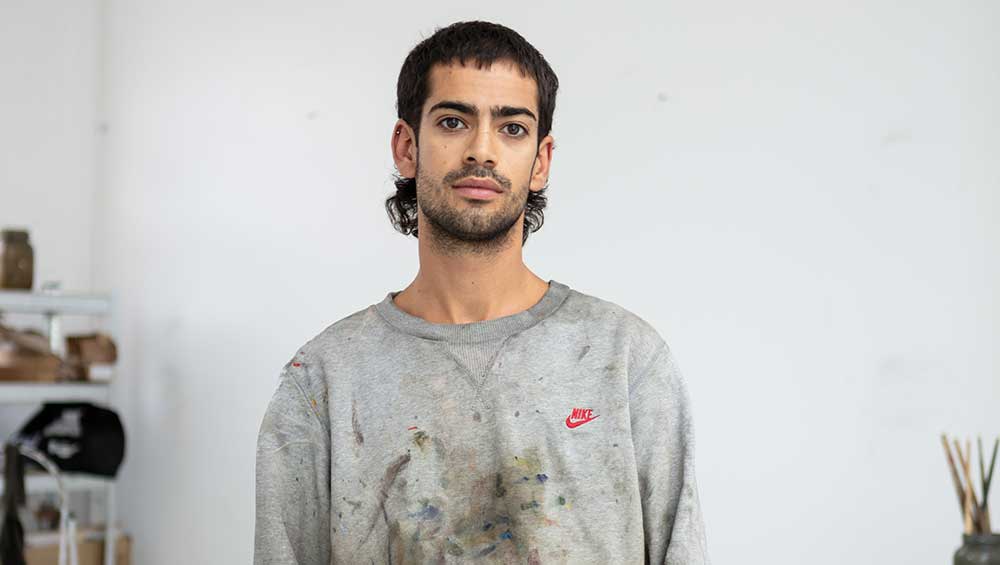
Jake Grewal portrait. Photo: Annie Tobin.
by ANGERIA RIGAMONTI di CUTÒ
There’s a particular sense of incantation in the silently charged works of Jake Grewal (b1994, London), a series of oil paintings and impressively modulated charcoal drawings displayed in a single room of Pallant House, easily commanding the space. Grewal uses landscapes as a form of self-portraiture, setting interior feelings and transitory moments within natural habitats of indeterminate time and place, his ephebic figures at times secreted away at the image’s periphery, at others pictured at a cinematic middle distance, and occasionally shown in cropped, assertive closeup.
As in most potent landscape painting, nature’s forms possess as strong a presence as any human figures in Grewal’s pictures, at times being almost indistinguishable from one another, as in woodland scenes such as No One Said How It Hurts and Knitted Flesh // As We Grasped We Lost (both 2023). Forests have been signifiers of many, sometimes disparate, forces in art and literature: bucolic sanctuary from the constrictions of organised society, impenetrable mystery, psychological or ecological retreat, but also a site of menace, obscurity and alienation from the consolations of human connection. In one its most memorable references in European culture, Dante’s Inferno, the dark wood (selva oscura), is a place of existential disorientation, the fraught setting for the protagonist’s midlife crisis. The forest can be a place for getting away from it all and, conversely, if not quite paradoxically, a site for confronting our deepest selves, with all the discomfort that might entail, and Grewal persuasively exploits these ambiguities.
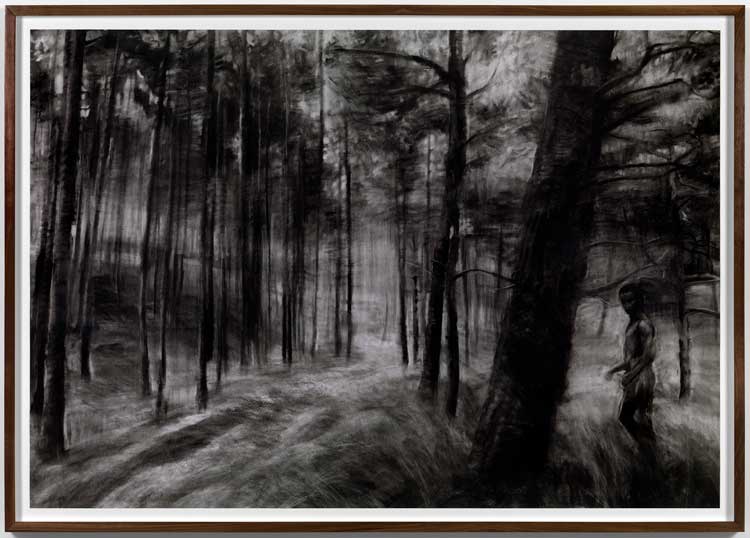
Jake Grewal, No One Said How It Hurts, 2023. Charcoal on paper, 140 x 201.3 cm (55 x 79 1/4 in). © Jake Grewal. Courtesy the artist and Thomas Dane Gallery. Photo: Todd-White Art Photography
For all their intimate, self-probing quality, there is an ineffability to these images that forms a marked contrast to the flagrant hedonism of John Craxton, whose works are being shown just a few rooms – but entirely another world – away. Between these two realms lies a series of smaller spaces displaying a selection of neo-Romantic images selected by Grewal from the museum’s permanent collection, paintings and works on paper by artists including Prunella Clough, Keith Vaughan, Graham Sutherland and Paul Nash.
Studio International spoke to Grewal at his studio in east London earlier this month.
Angeria Rigamonti di Cutò: Can you tell me about your formal training, a fine art degree at the University of Brighton, an MA at the Royal Drawing School and a stint at the Rhode Island School of Design Drawing Marathon. What were those programmes like and how much do you think they formed you? And why the choice of specialising in drawing, which seems such a crucial component of your work?
Jake Grewal: I grew up in London, so it was incredible to leave, be away from my family and have three years where I just studied painting. Although my practice has changed a lot since then, the idea that I could dedicate so much time to painting gave me a lot of confidence when I left that I could paint quite well. I knew enough about oil painting and how to stretch my own canvases to attempt studio practice when I left.
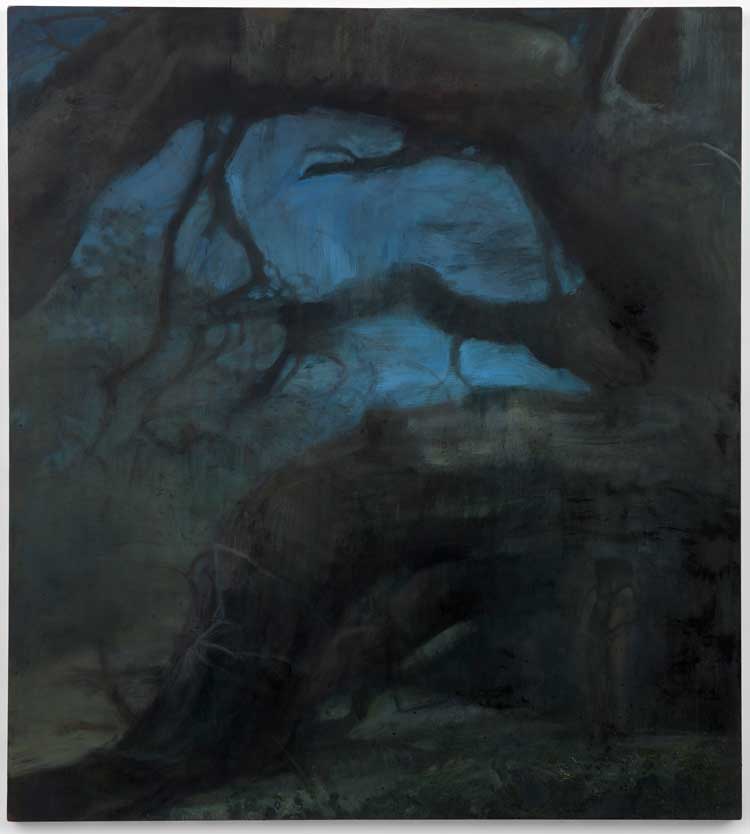
Jake Grewal, Knitted Flesh // As We Grasped We Lost, 2023. Oil on canvas 201 x 180 cm (79 1/4 x 70 3/4 in). © Jake Grewal. Courtesy the artist and Thomas Dane Gallery. Photo: Todd-White Art Photography.
When I was finishing in Brighton, I immediately wanted to go the Royal Drawing School because I felt I had really negated a part of my practice, which was drawing from observation, being outside and learning through practically doing. But I didn’t get in, so I tried having a studio practice for two years, applied again and got in. I then felt on top of what I’d learned in Brighton, which was essentially how to handle materials, more than what I wanted to say. I struggled at Brighton to join drawing and painting and it was only after the Drawing School that I realised they’re actually the same thing.
ARC: What’s interesting about your technique is that you seem to have no binary sense of what drawing and painting can do, having a painterly, fluid application of charcoal, enhanced by an equally painterly use of a rubber, while occasionally your paintwork can be quite graphic – as in Eaten//Fled Tears (2021). You seem to have an expansive approach to the different mediums.
JG: They definitely inform one another, and the drawing marathon in Rhode Island really exploded my mind. We were only allowed to draw in charcoal for two weeks from a still life, and then put our own ideas into the charcoal, not doing still lifes anymore but doing our own concepts. The way we were using the medium felt incredibly painterly. I use a special compressed charcoal from the US, nothing like willow charcoal from the UK that just wipes off completely.
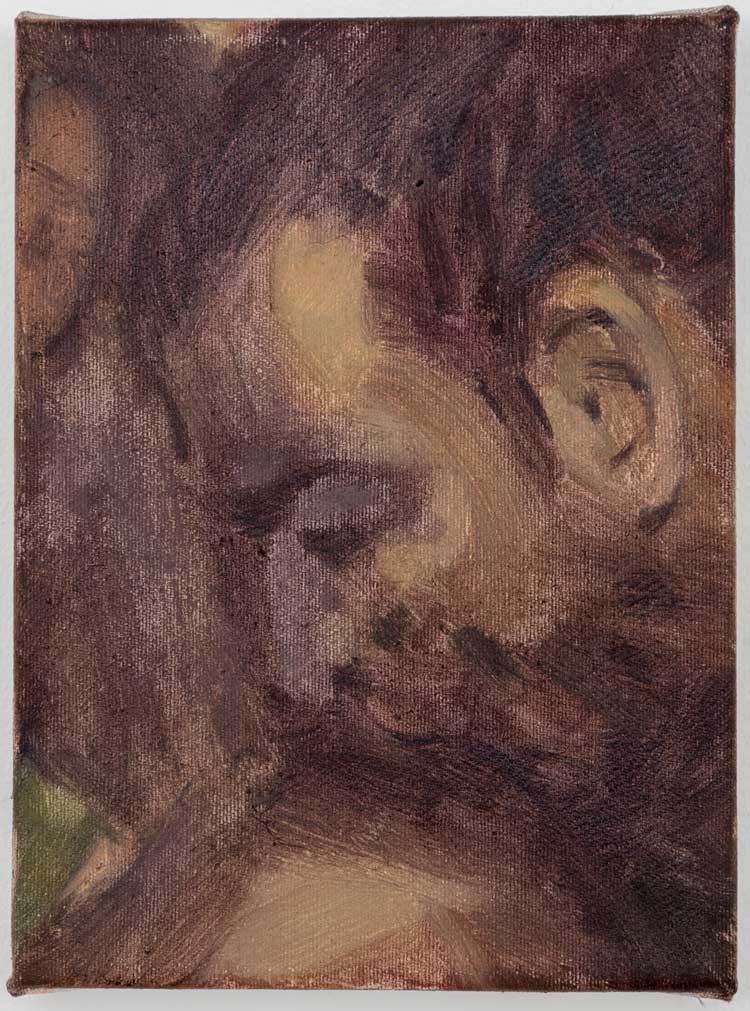
Jake Grewal, Eaten // Fled Tears, 2021. Oil on canvas, 20.1 x 15 cm (8 x 6 in). Private Collection, London. © Jake Grewal. Courtesy the artist and Thomas Dane Gallery. Photo: Richard Ivey.
This charcoal is more like paint, you can layer it up, make a mark and eradicate it, go really dark and deep, or really light, using it in big strokes without it muddying. You can be quite distinctive but also abstract and it really helped me think about painting in terms of drawing.
I look at Frank Auerbach’s charcoal portraits, he draws faces in a painterly way; you can see how he rubs and rips through the page. And because they’re monochromatic I’ve always thought about John Virtue’s sea paintings. Looking at those monochrome references is helpful in figuring out gesture and atmosphere.
ARC: Your figures seem to have been more often foregrounded in your earlier work, while at Pallant House you have some monumental pieces in which the landscape dominates and the figures are not always easily discernible: at times, I had to really fix on the image before I could grasp them. Did you consciously want to change the relationship between figures and landscape? I found that, perhaps counter intuitively, the figures felt even more important in these works, despite being so secretive.
JG: It was definitely conscious; I didn’t want the figures to be as confrontational. Previously, I was more present in the work, trying to make creative decisions in my life and practice and that was coming through as the figure being more direct towards the audience. For the show at Pallant House, it was more about relationships with other people and how I sit in a bigger conversation in my world. I’m not so introverted and analytical about myself now.
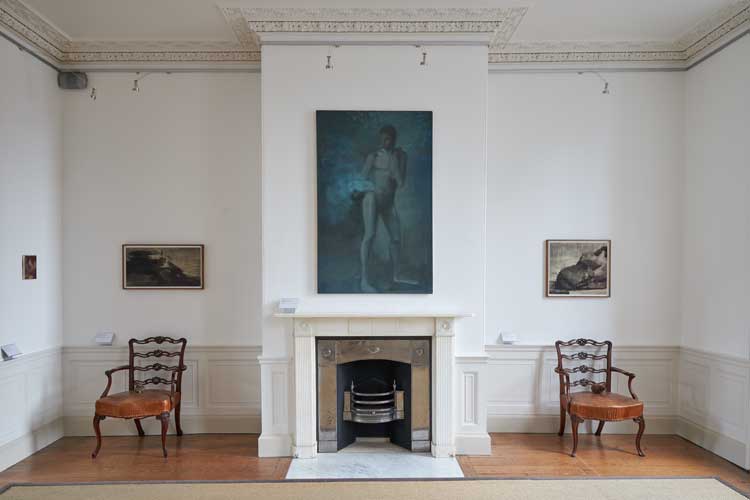
Jake Grewal: Some days I feel more alive, installation view, Pallant House Gallery, 28 October 2023 - 21 April 2024. © Courtesy Pallant House Gallery, Photo: Barney Hindle.
ARC: You have said that you consciously use yourself in your painting. From what you’re saying, the extent to which you do this has changed over time, perhaps becoming less explicit?
JG: It is still important for me; otherwise, I don’t know where I make work from, other than my experience and emotional response. I feel a kind of duty to allow myself the space to honestly express myself – though not analysing to the degree that I was before – be it in writing or in the studio. That’s the place where the work comes from, these spaces of reflection and meditation. A thought might come up, I find myself suddenly in the past, perhaps a horrible feeling or experience comes and that informs the work, but the work doesn’t depict it, it’s more of a conversation I want to have with myself.
So, I still use myself and the figures still bear a resemblance to me, but I feel they’re becoming more abstract and more embedded in the landscape as you say, in dialogue with their environment and the other figure they’re with, rather than me showing myself.
ARC: Another component you exploit to inform the meaning and atmosphere of your works are your titles. Aside from sometimes offering a code referring to how many figures are present, they’re decidedly emotive, evoking yearning, loss, tears and the difficulty and consolation of communication (only one here has a neutral, non-committal title: Plein Air, Tuscany). The wording seems important in the construction of your painting: how do writing and text figure in your work?
JG: That was actually one of the titles where I wondered: “Should I write Tuscany or not?” Because I really like the fact that my work is untethered to any place, but I thought it was important to expose the process by which some of these works were made. Especially in the case of this exhibition where there was a conversation with the works of the neo-Romantics whose works I curated. They drew a lot from life, so it felt important in the case of that painting to reference a real place.
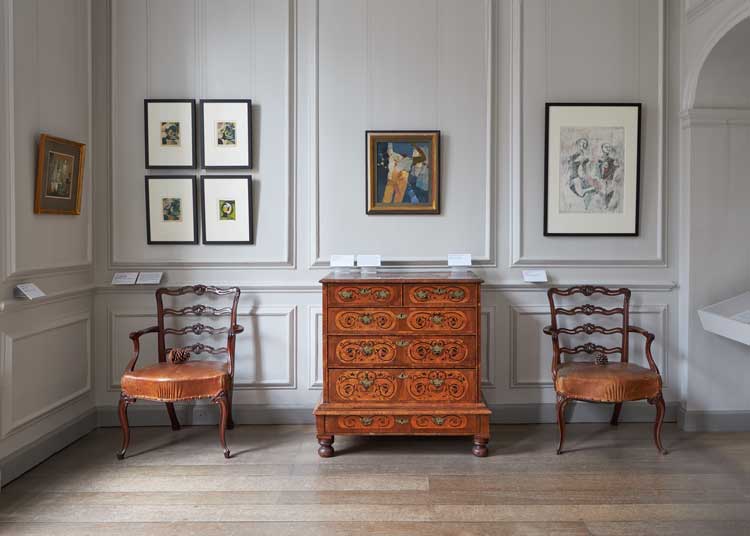
Jake Grewal: Selects, installation view, 2023 © Courtesy Pallant House Gallery, Photo: Barney Hindle.
My titles mostly come from notes; there was a period where I did morning pages every day, three pages of automatic writing, though I do this less often now. I also write notes in my phone, it tends to be two months of real outpour that gets the ball rolling, then I go to the studio or a museum. It’s less consistent but when it comes, it really comes and I can’t stop. Because I have this archive of writing and journalling, I always refer to them when titling and try to put myself back in that space emotionally when I’m trying to understand where my work has come from.
ARC: Another standout feature of your work is the contrast of scale and framing: there’s a striking disparity between the monumental pieces and the small works. And in terms of framing, although there are paintings here where the human figures are obfuscated by the natural elements, others are extreme closeups, with the edges cropped. I assume there’s a conscious decision to play around with these effects. Do you maintain an awareness of how pictures will work together as well as concentrating on the single images?
JG: It’s interesting because I never really know what a show’s going to look like until I have all the works there. I had a vague idea about the space before I made the work, but I was just making work that I felt encapsulated the last six months or so.
I do try hard to offer different elements within an exhibition, I don’t want to repeat myself or for it to become one-note, which is why I play with diverse tonalities, ground of the paper and sizes, and the works have different focuses.
At the end of the room there was a drawing of a figure in reeds walking through the water and it was quite a weird drawing because it was unlike the others, it felt more like an abstraction than a depiction of a figure in the landscape.
Some works have a deeper meaning, for instance the image of the two figures on the rock [Too Much to Say (2023)], was speaking more about adolescence, or the relationship between the two and the barrier of the rock, it was more metaphorical.
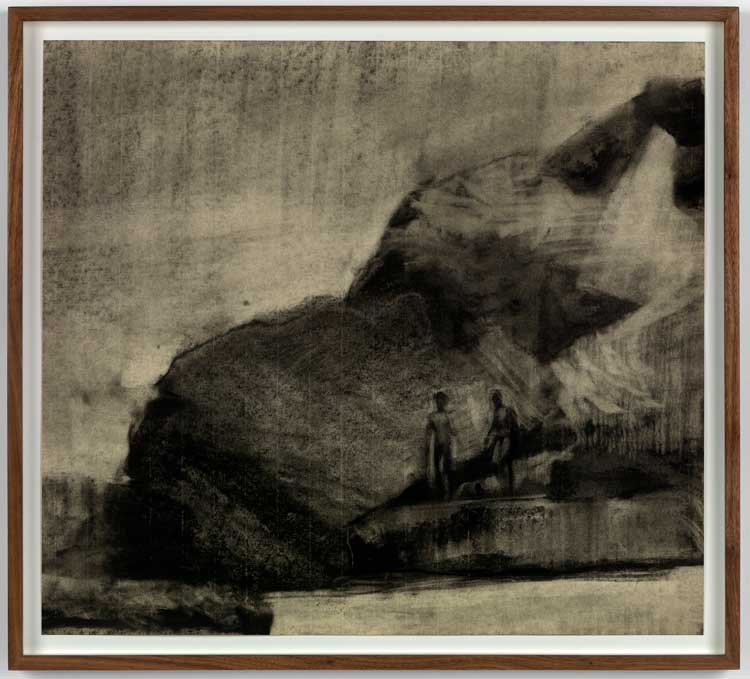
Jake Grewal, Too Much To Say, 2023. Charcoal on paper, 50 x 56 cm (19 3/4 x 22 in). © Jake Grewal. Courtesy the artist and Thomas Dane Gallery. Photo: Todd-White Art Photography.
Others are more an interrogation of making, so those different interests lend themselves to variations within the show. I was very cautious about not having too many figures of the same size on the same wall, though I was thinking about intimacy so perhaps that’s why there were so many figures.
ARC: Showing concurrently at Pallant House is another solo exhibition, by John Craxton, and you’ve also selected some works from the permanent collection. How aware were you of these other presences when working on your own show? You are clearly a careful observer of other artists’ work, as shown in the wall texts you wrote for your chosen images in the museum’s collection.
JG: Not so much the Craxton, but over the last three years I’ve been quite obsessed with Keith Vaughan and the neo-Romantic movement, looking at a lot of Graham Sutherland and Paul Nash, and John Minton and Craxton by proxy. When I was figuring out my own language in painting and drawing, I was looking at them, so it all fitted in quite well.
With Craxton, I’m not sure whether there’s a relationship there, other than an interest in painting from observation, and maybe this kind of cubist thing he does which is quite interesting. I hadn’t really processed it and was thinking quite a lot about cubism, the altering of reality through looking and the capturing of movement within a still image, though I’m not sure it’s showing in the work yet.
I was very involved in the hang of the show of the works from the collection that I selected. I really wanted to hang the Graham Sutherland Entrance to a Lane studies and they’re done diaristically as I wanted them to mirror my own diaristic interest – he captured that lane as time passed, and I wanted that to be an important element of the room.
The Paul Nash Frozen Lake also has an element of the transience of time and the materiality of water that could change at any moment. Those concepts have an interesting relationship to my own work, whether it’s going back in time to recapture a past feeling or acknowledge the body as a kind of transient material thing that I can either eradicate with an eraser or blend into the landscape.
ARC: The exhibition title is itself a diary entry from Keith Vaughan’s journal.
JG: I need to re-read it because I read it before the show, not knowing that I would be asked to do an exhibition and curate a neo-Romantic room. The title came from when I read the diary and I underlined the words thinking they were interesting, but he wasn’t in the forefront of my mind when I was painting the show, though I was referring to a knowledge that I’d already obtained.
I had an awareness of parallels in visual language between the works that I made and the ones I selected – another being the vortex in the Sutherland studies, which is similar to Turner whose vortex paintings I’ve always loved. But I certainly wasn’t studying specific images on my wall, which is sometimes a way that I work.
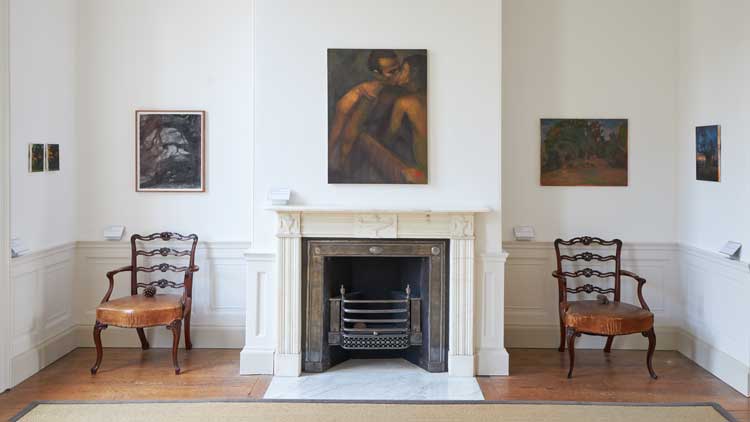
Jake Grewal: Some days I feel more alive, installation view, Pallant House Gallery, 28 October 2023 - 21 April 2024. © Courtesy Pallant House Gallery, Photo: Barney Hindle.
ARC: Does it mean something to you to be part of a particular painterly tradition, in your case the neo-Romantic one with which you’re being associated, though you’ve presumably also looked at a lot of 18th- and 19th-century landscape painting, or are these labels affixed by others for the convenience of classification?
JG: It’s interesting, I don’t know. I think at some stage that was probably important and I was looking to them very directly, but the breadth of the people that I look to has expanded so I find myself less and less wanting to attach myself to a particular school. I think there is an element of beauty and the overtly poetic that people see but I also feel – though perhaps I’m not making it obvious enough – that there’s a kind of aggression or edge to my work.
ARC: There seems to have been a real arc in the development of your work and it feels fully formed here. Do you see this exhibition as a kind of culmination of the first years of your career?
JG: It did feel like a progression, even from the show I had at Thomas Dane earlier this year, though that too felt like a culmination after years of trying to have a gallery show in London. In this show, I felt as if I was asking more of myself, and it felt harder but also easier. It seemed more tumultuous to make it, I was trying to take more risks.
Maybe the time limit had an impact too. There was more wet-on-wet painting and less time to put the work away and come back to it as I normally would, so it felt a bit like a carousel. It seemed like a moment when I didn’t need to rest on anyone, other than the amazing assistant curator Lydia Miller, but I was making all these decisions for myself and trying to take ownership of my own perspective.
If anything, seeing the work together in the room really made me want to move on to the next phase, whatever that may be; I feel a pull towards something I haven’t done before, perhaps something more direct.
ARC: Painting has been the subject of various portentous announcements of its demise. Are these essentially futile, since painting, like the novel or other endangered species, tends to find new, particularised forms of life, which is probably more important than ever given the impending dangers of artificial intelligence obliterating the specificity of human input? You presumably have an inherent belief in painting and drawing since you chose them.
JG: We can’t know what will happen, but I would have to believe, or choose to believe, that people are going to want to continue to share their perspective and other people are going to be interested. Even on a small, day to day level, how is going to a self-checkout more interesting than speaking to a cashier? I feel that as things are moving to a more technological space, people want connection more and more, and something that someone has made offers that, a kind of I-see-you/you-see me vulnerability that AI can’t provide.
• Jake Grewal: Some Days I Feel More Alive is at Pallant House Gallery, Chichester, until 21 April 2024.